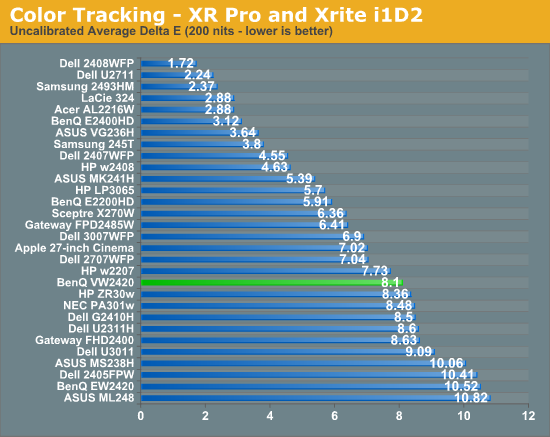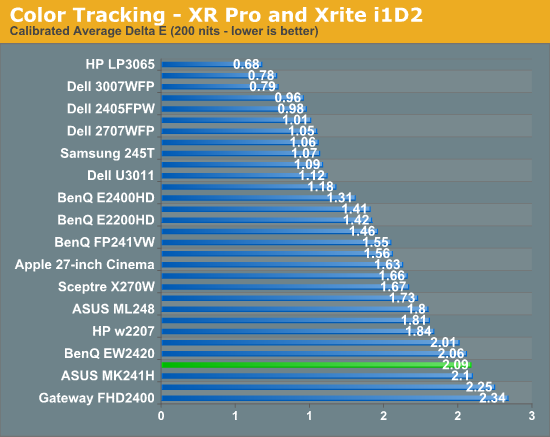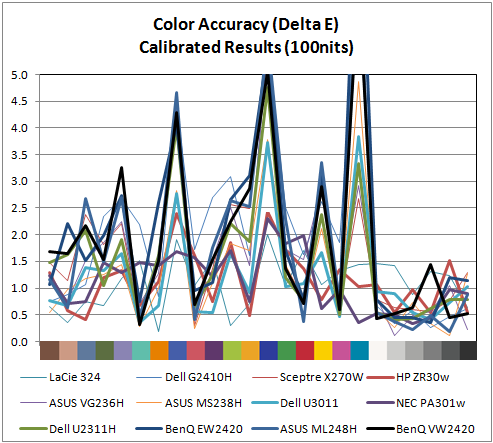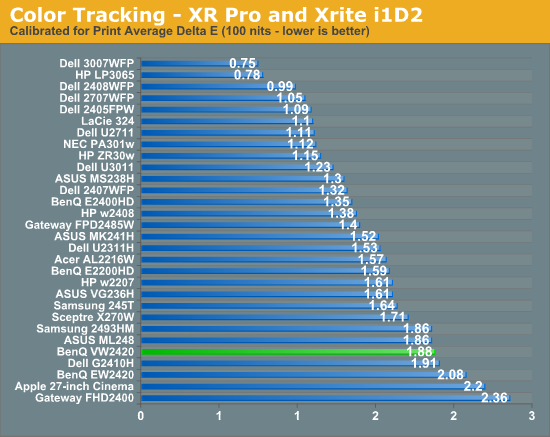BenQ VW2420H Monitor Review
by Chris Heinonen on December 10, 2011 2:45 AM ESTViewing Angles and Color Quality
The BenQ uses a *VA panel (specifically A-MVA) and because of that the viewing angles on it are overall very good. You can get a bit of contrast shifting when you move to the extremes, but for all practical purposes there should be no real contrast shifts while working on it. Since this is designed just for desktop work and not for multiple people to use while gaming or watching TV, the viewing angles are very good.
When initially hooked up and set to 200 nits of light output, the average dE of the BenQ is in the high single digits, which unfortunately is very good for a consumer class LCD monitor—only higher quality professional (or at least prosumer) displays tend to be factory calibrated for accurate colors. The worst color is pure white, with the rest of the grayscale getting better as it gets darker, but overall this isn’t a monitor you would want to use for serious color work straight out of the box.


Of course, the uncalibrated results won’t be that important to people that care about color quality, since they would be calibrating the monitor regardless of the performance out of the box. In this case the BenQ performs well, though it's strictly average for a consumer display. Our average dE comes down to just about 2, and the majority of the grayscale is at 1 or below. The main errors are in the blue swatches that cause most displays issues, or fall outside of the sRGB colorspace. Calibrated the BenQ falls strictly in the “good, not exceptional” category for dE performance.


If you are doing print work and using a light output of closer to 100 nits than 200 nits, the performance of the BenQ is slightly better, but still in the range of most displays. The grayscale is more accurate which I like to see, and the color errors are in the same positions as before. If the 200 nits calibration data was close enough to accurate for you, then the 100 nits calibration data will be good enough as well, but the numbers are very similar.












48 Comments
View All Comments
JediJeb - Saturday, December 10, 2011 - link
The only thing worse is when the make the screen shiny too. It is why I haven't bought a new notebook as most lower priced ones now days have the reflective glossy screens that are useless unless you are using them in the dark.danchen - Saturday, December 10, 2011 - link
Will the 16:10 layout ever make a comeback ?Seems only Dell & apply are still making them.
and yeah, i agree that the shiny thick bezels are unwelcome. I am looking for 3 monitors to do an eyefinity setup, and despite any good reviews, the bezel alone will turn me away.
dingetje - Saturday, December 10, 2011 - link
benq can shove its 16:9 panel where the sun don't shine.16:9 is useful for movie watching and not much else.
kesbar - Saturday, December 10, 2011 - link
^^^^ This.Stop encouraging the 16:9 market.
BansheeX - Saturday, December 10, 2011 - link
Clinging to some tiny deviance like 16:10 is asinine. We don't want a recorded desktop to be chopped off vertically or downsampled when played back on a television or projector. We need uniformity with regards to aspect. Maybe someday they will release a 3840x2160 monitor and you resolution junkies will shut the heck up about aspects.TegiriNenashi - Monday, December 12, 2011 - link
16:10 should have been HDTV standard to begin with. (I personally find ratio 16:11 even more pleasing). It is silly living in 21st century and being forced to watch content in aspect ratio one hates (yes, I'm speaking of ridiculous short letterbox 2.41:1) .psychobriggsy - Tuesday, December 13, 2011 - link
Letterbox 2.41:1 really requires a 100" display or more. The idea is to totally immerse the viewer even if the edges aren't where the action is happening.I think that until such large TVs are mainstream DVDs and BluRays should just stick to 16:9 formats that fill the entirety of the TV screen.
TegiriNenashi - Tuesday, December 13, 2011 - link
I have 100" projector screen in 4:3 ratio for almost a decade. Its ginormous (for a small room). 100" letterbox image is much less spectacular, as you would could clearly feel the lack of height. It's all about virtual reality, filling out the full field of view -- IMAX (4:3) pushing the viewing excellence. Again those 1950 ideas of "impressive" visual are out of touch with today's reality.psychobriggsy - Tuesday, December 13, 2011 - link
I treat it as being a 1680x1050 monitor but with 240 more pixels on the edge, and 30 on the bottom, rather than being a cut down 1920x1200.What I want is a 24" 2560x1440 monitor. And in a couple of years why not a high DPI 3840x2160!
TegiriNenashi - Tuesday, December 13, 2011 - link
Do you know that given two displays with the same diagonal, the narrower one has less area? That is 16:10 being 6% smaller than 4:3, and 16:9 being even smaller: 7% less than 16:10. That is why manufacturers are so in love with "True HD" -- at consumers expense.Nevertheless 4K displays (to appear next year) are welcome development in this stagnated field. The price for 30" 2500x1600 display has been flat for 5 years -- the situation unheard of in electronics.